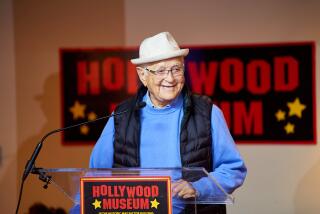A void, and yet his legacy does live on
For Helen Mendoza, 39, Fred Rogers was an acquired taste. âIf you had asked me as a kid, whatâs the top 10 most entertaining shows, I donât think Mr. Rogers would have been in my top three,â she said. Now, as a parent of two, Mendoza said she will miss the comfort of his gentle and reassuring presence.
She is grateful, though, that her 3-year-old, Grace, has the chance to see the calm and respectful childrenâs show host in reruns, which, she said, offer an antidote to commercial television and âoverly happy, overly musicalâ kidsâ programming.
In the decades since Fred Rogers took to the airwaves, society has undergone huge changes, and yet the only thing that changed about Mr. Rogers, who died early Thursday at 74, was that his hair got gray. His message to children was always the same -- you are lovable just the way you are.
In person, many were delighted that he was just like his humble on-screen persona, with his soft voice, sweaters and tennis shoes. âThat was comforting,â said Mendoza, who once met him on a college campus.
âItâs one of those things: You expect him to be there,â says television writer Angela C. Santomero, co-creator and head writer of the Emmy-winning childrenâs show âBlueâs Clues.â âThereâs going to be a void now,â she said. Rogers was a pioneer in childrenâs television âin proving that you really can put the child first and educate them and give them positive self-esteem messages and amazing role models,â she said.
âHeâs irreplaceable,â said George Gerbner, dean emeritus of the Annenberg School for Communication at the University of Pennsylvania in Philadelphia. âNo one is likely to take his place. The rating game is too unforgiving now. The media monopoly is so strong and so brutal that only ratings count. His type of program would not be as profitable for the advertisers to support.
âHe was the one childrenâs program that talked to children in their language,â Gerbner said. âHe was able to tell stories and to speak to them directly, kindly, softly, and not talk down to children. No other childrenâs program has since been able to do that,â said Gerbner, who coined the term âmean world syndrome,â referring to how violence in television affects children.
Gerbner said children today are born into a world in which television is on seven hours a day. âThereâs no escape; indoctrination starts in infancy,â he said.
Jane Rosenberg, director of the childrenâs school at Pacific Oaks College in Pasadena, is one of many educators of young children concerned about the fast-paced, overstimulating aspect of most childrenâs programming. âStudies indicate children under 8 watch an average 35 hours a week of screen time. Itâs incredibly inappropriate.â
Not only did Rogers have an unhurried, calming effect on children, he also had a unique talent of being able to communicate with them on âtender topics,â such as death, divorce or such common fears as being hospitalized or falling into a toilet and being flushed away, Rosenberg said. âHe once wrote a song for children, like, âYou wonât flush down the toilet.â Itâs true. He had a willingness to address those topics in a way that was developmentally appropriate for young children.â
In that way, he was also a role model for parents in how to treat and talk to children. âHe was my hero,â Rosenberg said.
Rogers was a âsquare man who refused to yield to the wave of hipness and irony that infiltrated popular culture in the late 20th century, including childrenâs television,â said Robert Thompson, president of the Popular Culture Assn. and a professor at Syracuse University. âIf âSesame Streetâ was one side of the hip, Madison Avenue, fast-paced, hallucinogenic [wave], the other side was Fred Rogers, looking backward, kind, gentle, warm and fuzzy. He was one of the last of his kind.â
Along with Peanuts cartoonist Charles Schulz, Rogers will be remembered as one of the nicest things about the 20th century, Thompson said. âHis show was aimed at 5-year-olds who havenât yet developed a sense of irony,â he said. But his neighborhood was still a warm place for 40- or 50-year-olds to go. âYou could almost taste the warm oatmeal once again.â
Although it seems to many as if no one else is carrying on his gentle style, Rogers has left a legacy of inspiration for several preschool productions. Two of the leading successors are Nickelodeonâs Nick Jr. show âBlueâs Cluesâ and the Disney Channelâs âBear in the Big Blue House.â
Santomero calls Mr. Rogers an inspiration. Like him, âBlueâs Cluesâ has a gentle, human host and a script that adheres to child developmental principles.
âHe totally was a model for us,â says Mitchell Kriegman, creator of âBear in the Big Blue House,â the Disney Channelâs Emmy Award-winning show from Jim Henson Television that stars a gentle 7-foot-tall bear. âWe had the Harvard educators and advisors and all sorts of people, but we always looked to Mr. Rogers to see what Mr. Rogers did. He understood the tone, which is so important. Kids are great appreciators of tone.
âWe aspired to find ways to talk to the audience the way he did and create the trust that he did. I think this is what is incredibly enduring about what he did: You felt it as a child, you felt it as a parent; in watching the show you saw that he cared for children and wanted them to grow but be protected.â
More to Read
The complete guide to home viewing
Get Screen Gab for everything about the TV shows and streaming movies everyoneâs talking about.
You may occasionally receive promotional content from the Los Angeles Times.






